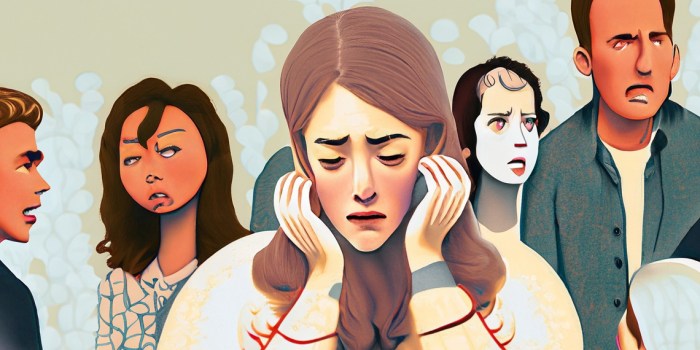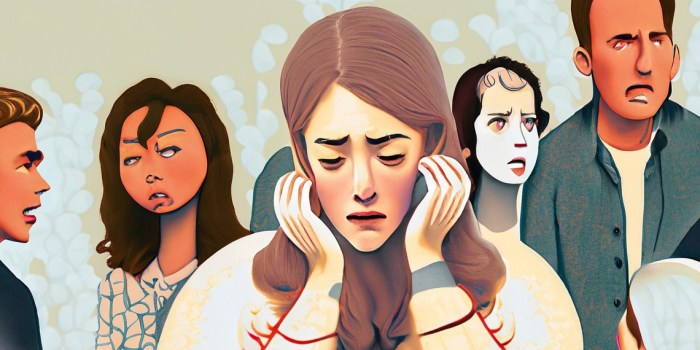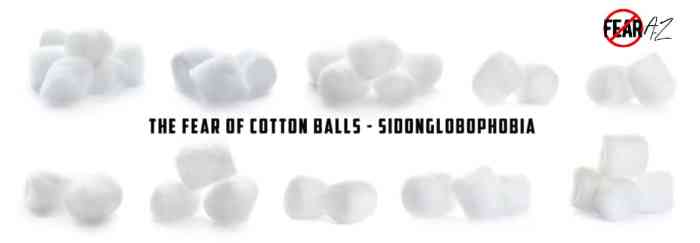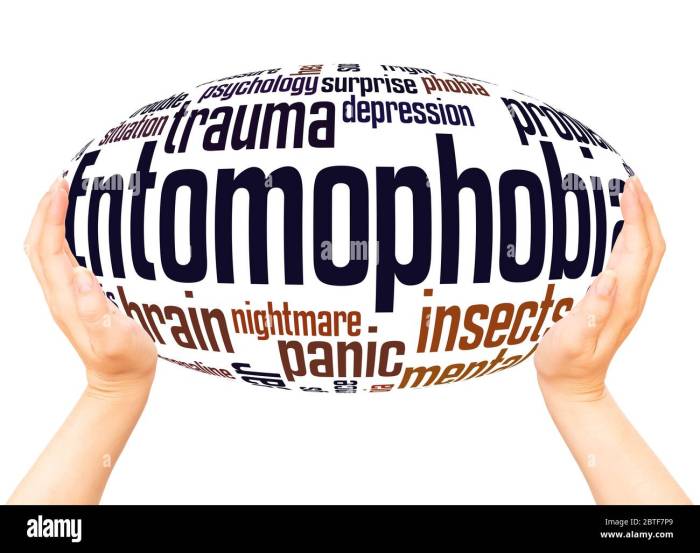Fear of people anthropophobia – Fear of people, anthropophobia, is a specific phobia characterized by an intense and persistent fear of other people. It’s different from general social anxiety, often focusing on a broad range of social situations rather than a specific fear of interaction. This fear can vary in severity, from mild discomfort to debilitating avoidance, impacting every aspect of a person’s life.
Understanding this complex phobia, its causes, symptoms, and treatment options is key to providing support and fostering understanding.
This comprehensive exploration delves into the multifaceted nature of anthropophobia, examining its various dimensions from defining the phobia itself to exploring the impact it has on daily life. We will explore the diverse coping mechanisms and treatment approaches available, highlighting the importance of culturally sensitive care. Case studies will illustrate the real-world challenges faced by individuals grappling with this fear.
Ultimately, this article aims to shed light on anthropophobia and empower readers with knowledge and compassion.
Defining Anthropophobia
Anthropophobia, a specific phobia, is characterized by an intense and persistent fear of people. This fear can manifest in various ways, impacting daily life and causing significant distress. Understanding the nuances of this phobia is crucial for recognizing and addressing it effectively. It’s important to note that while social anxiety is common, anthropophobia is a distinct and more severe form of fear.Anthropophobia differs from general social anxiety in its intensity and focus.
While social anxiety involves discomfort in social situations, anthropophobia centers on a deep-seated dread ofall* people. This fear often extends beyond a concern about social interactions, leading to avoidance of situations where people are present. The individual may experience a heightened sense of danger and vulnerability around people, making it difficult to engage in ordinary social activities.
Severity of Anthropophobia Experiences
The severity of anthropophobia varies significantly among individuals. Some people experience mild discomfort in the presence of people, while others find it virtually impossible to interact with others, leading to extreme isolation. This range in severity is influenced by factors like the individual’s personal history, the specific triggers, and the support systems available. Mild cases may involve a heightened awareness of people and a tendency to avoid crowds, while severe cases might result in agoraphobia-like symptoms and a complete withdrawal from social life.
Comparing Anthropophobia with Other Phobias
Understanding how anthropophobia compares to other phobias can provide a clearer picture of its unique characteristics. This table Artikels key differences:
| Characteristic | Anthropophobia | Specific Phobias (e.g., Arachnophobia, Acrophobia) | Social Anxiety Disorder |
|---|---|---|---|
| Object of Fear | People (or large groups of people) | Specific objects, animals, situations | Social situations, interactions, judgments |
| Nature of Fear | Intense fear of harm, danger, or negative evaluation from people | Fear of harm from the specific object or situation | Fear of negative evaluation, embarrassment, or humiliation in social situations |
| Avoidance Behaviors | Avoidance of social situations, crowds, or any situation with people. | Avoidance of the specific phobic object or situation. | Avoidance of social situations to prevent anxiety |
| Impact on Daily Life | Can significantly impact work, education, relationships, and daily routines. | Impacts daily life depending on the object or situation and the individual’s experience. | Can significantly impact work, education, relationships, and daily routines, especially if untreated. |
The table illustrates the key differentiators between anthropophobia and other phobias. It highlights that anthropophobia’s core fear is people, distinct from the specific triggers of other phobias or the social judgment concerns of social anxiety. While avoidance behaviors can be present in all three, the focus and intensity of the fear differ.
Symptoms and Manifestations

Anthropophobia, the fear of people, manifests in a variety of ways, impacting an individual’s physical, behavioral, and emotional well-being. Understanding these diverse expressions is crucial for recognizing the condition and providing appropriate support. The following sections detail the common symptoms and manifestations associated with varying degrees of anthropophobia.The experience of anthropophobia is highly personal and can range from mild discomfort to debilitating panic.
Recognizing these diverse expressions is key to understanding the severity of the condition and facilitating appropriate intervention strategies. The symptoms, as with many phobias, can be triggered by different factors and vary significantly between individuals.
Physical Symptoms
Physical manifestations of anthropophobia are often subtle, but can be quite distressing for those experiencing them. These symptoms frequently arise as a response to perceived threat or anticipation of social interaction. These reactions are rooted in the body’s natural fight-or-flight response, amplified by the intense anxiety associated with the phobia.
- Increased heart rate and rapid breathing are common. These physiological responses reflect the body’s heightened state of alertness. A person may feel their heart pounding or experience shortness of breath, even in situations that would not normally trigger such a reaction.
- Sweating, trembling, and dizziness are additional physical responses. These are all indicators of heightened anxiety and the activation of the sympathetic nervous system. These physical symptoms can contribute to the individual’s feeling of unease and discomfort in social situations.
- Nausea, stomach cramps, and headaches are also possible. These bodily sensations, while not always directly related to the fear of people, are common responses to overwhelming anxiety. They can be distressing and make social interaction even more challenging for the individual.
Behavioral Responses
Behavioral responses in individuals with anthropophobia often reflect an avoidance of social situations. These avoidance strategies can significantly impact the person’s life and relationships. The behaviors are largely unconscious attempts to mitigate the anxiety associated with social interaction.
- Social isolation is a common behavioral response. Individuals may withdraw from social gatherings, parties, and other activities involving large groups of people. This avoidance pattern can lead to feelings of loneliness and isolation, exacerbating the anxiety.
- Difficulty initiating conversations and maintaining eye contact. These behaviors can stem from a fear of judgment or rejection. They can be evident in both casual interactions and more formal settings.
- Staying quiet and unassertive in social situations. This behavior is another coping mechanism to avoid perceived judgment or conflict. This can result in individuals feeling unheard or misunderstood.
Emotional Responses
Emotional responses associated with anthropophobia are characterized by intense fear, dread, and even panic attacks. These emotional reactions are central to the experience of the phobia. The anxiety is often disproportionate to the perceived threat, highlighting the significant impact of the fear on the individual.
Dealing with anthropophobia, that fear of people, can be tough. It often manifests in physical symptoms, like a strange tightness in your chest or a sudden, unexpected lower back pain when walking. This physical discomfort can sometimes feel overwhelming, mirroring the emotional distress associated with social situations. Ultimately, though, the fear of people itself remains the core issue.
Understanding these connections can be crucial for effective treatment and overcoming the challenges of anthropophobia. lower back pain when walking
- Fear and dread of social interactions are the core emotional experiences. These feelings can be overwhelming, making it challenging to participate in everyday activities.
- Panic attacks, marked by intense fear and physical symptoms like rapid heartbeat and shortness of breath, can occur in situations involving other people. These attacks can be highly distressing and can make social interactions feel extremely dangerous.
- A pervasive feeling of inadequacy and low self-esteem can also accompany the phobia. The fear of being judged or evaluated negatively can lead to feelings of self-doubt and worthlessness.
Symptom Severity Levels
| Severity Level | Physical Symptoms | Behavioral Responses | Emotional Responses |
|---|---|---|---|
| Mild | Occasional anxiety, slight physical discomfort | Slight avoidance of some social situations | Generalized unease, mild fear |
| Moderate | Frequent anxiety, noticeable physical symptoms | Significant avoidance of social situations, difficulty initiating conversations | Dread, intense fear, occasional panic |
| Severe | Persistent anxiety, debilitating physical symptoms | Complete avoidance of social situations, inability to interact with others | Intense dread, overwhelming panic, significant distress |
Causes and Contributing Factors
Understanding anthropophobia requires delving into the multifaceted factors that contribute to its development. While there’s no single cause, a combination of genetic predispositions, adverse childhood experiences, learned behaviors, and potentially other underlying psychological factors often play a role. This exploration will examine these potential influences to provide a more comprehensive understanding of this anxiety disorder.Genetic predispositions may influence an individual’s susceptibility to developing anthropophobia, but environmental factors are crucial in triggering or shaping the specific manifestation of the disorder.
Research suggests that individuals with a family history of anxiety disorders might be more prone to experiencing social anxieties, including anthropophobia. However, this doesn’t guarantee that a person will develop the disorder. The interaction between genetic vulnerability and environmental experiences is likely complex and multifaceted.
Genetic Predispositions
Genetic factors can play a role in an individual’s susceptibility to anxiety disorders, potentially including anthropophobia. Studies suggest that certain genes may influence the way the brain processes fear and stress responses. For instance, variations in genes associated with neurotransmitter systems, such as serotonin and dopamine, might contribute to an increased likelihood of developing anxiety-related conditions. While specific genes haven’t been definitively linked to anthropophobia, research into broader anxiety disorders provides valuable insights into potential genetic predispositions.
Childhood Experiences, Fear of people anthropophobia
Negative childhood experiences can significantly impact an individual’s development, potentially contributing to the emergence of anthropophobia. Experiences such as bullying, social isolation, or witnessing traumatic events can create a fear of social interactions and potentially shape the individual’s perceptions of others. For example, a child who repeatedly experiences ridicule or rejection might develop a deep-seated fear of social judgment and interactions, which could manifest as anthropophobia later in life.
Similarly, exposure to family conflict or instability could foster a heightened sense of anxiety around social situations.
Learned Behaviors
Learned behaviors play a vital role in shaping an individual’s responses to the world around them. Anthropophobia could stem from observing fearful responses in significant figures, such as parents or peers, to social situations. For instance, if a child consistently sees their parents displaying extreme anxiety in social settings, they might subconsciously learn to anticipate similar negative experiences and develop a fear of people.
Furthermore, classical conditioning, where a neutral stimulus becomes associated with a negative experience, can also contribute to the development of anthropophobia. If a person experiences a negative event in a social context, they may associate future social encounters with that negative emotion.
Theoretical Frameworks
Different theoretical frameworks offer varying perspectives on the causes of anthropophobia. These perspectives provide insights into the complexity of the disorder and the diverse factors contributing to its development.
Dealing with anthropophobia, that fear of people, can be tough. It can feel isolating, like you’re constantly battling an internal war. But sometimes, surprising things can help. For instance, taking a month off alcohol can surprisingly have a positive impact on your mental well-being, potentially reducing anxiety and improving social interactions. Check out what happens when you quit alcohol for a month for more insights.
Ultimately, conquering anthropophobia takes time and effort, but small steps like this can be powerful allies in your journey.
| Theoretical Framework | Explanation |
|---|---|
| Behavioral | Focuses on learned behaviors and conditioned responses to social situations, emphasizing the role of reinforcement and punishment in shaping fear responses. |
| Cognitive | Highlights the role of negative thoughts and distorted perceptions of social interactions in contributing to anxiety. Cognitive distortions, such as catastrophizing or overgeneralizing, can intensify fear and avoidance behaviors. |
| Psychodynamic | Emphasizes the influence of unconscious conflicts and early childhood experiences on the development of anxiety. Unresolved issues from childhood could contribute to the development of anthropophobia. |
| Biological | Considers the role of biological factors, such as genetics and brain chemistry, in influencing vulnerability to anxiety disorders. Variations in neurotransmitter systems or brain structure could increase the risk of anthropophobia. |
Impact on Daily Life
Anthropophobia, the fear of people, significantly impacts various aspects of daily life, creating challenges in social interactions, professional pursuits, and personal relationships. Individuals experiencing this fear often find themselves isolated and limited in their ability to participate fully in everyday activities. This isolation can have a profound effect on their overall well-being and quality of life.
Social Interactions
Social interactions are often fraught with anxiety and avoidance for those with anthropophobia. The fear of judgment, scrutiny, or unwanted attention can lead to significant discomfort and difficulty engaging with others. This fear can manifest in a variety of ways, from avoiding social gatherings to feeling overwhelmed in crowded spaces. Consequently, individuals with anthropophobia may withdraw from social situations, leading to feelings of loneliness and isolation.
They may struggle to maintain friendships and romantic relationships, impacting their overall social well-being.
Professional and Academic Performance
Anthropophobia can negatively affect professional and academic performance. The fear of interacting with colleagues, superiors, or instructors can hinder career advancement and academic success. Presentations, meetings, and collaborative projects become daunting tasks, potentially leading to missed opportunities and reduced productivity. This fear can lead to decreased confidence and self-esteem, further exacerbating the problem. For example, a student with anthropophobia might struggle to participate in class discussions or seek help from professors, hindering their learning experience.
Personal Relationships
The impact of anthropophobia on personal relationships can be devastating. The fear of intimacy, closeness, or vulnerability can make it difficult to form and maintain meaningful connections with others. The individual might struggle to express their needs and feelings, potentially leading to misunderstandings and conflict. Trust and openness, essential components of any strong relationship, become significantly challenging.
Individuals may feel isolated and unable to share their true selves with others, ultimately affecting the quality and depth of their personal relationships.
Impact Across Life Areas
| Life Area | Specific Impacts |
|---|---|
| Social | Avoidance of social gatherings, difficulty initiating conversations, feeling overwhelmed in crowded spaces, withdrawal from social situations. |
| Professional | Difficulty interacting with colleagues, fear of presentations and meetings, avoidance of collaborative projects, reduced productivity, and missed opportunities. |
| Academic | Fear of participating in class discussions, reluctance to ask questions, avoidance of seeking help from professors, potential for reduced academic performance. |
| Personal Relationships | Difficulty expressing needs and feelings, reluctance to form close connections, fear of intimacy, difficulty maintaining trust and openness in relationships. |
Coping Mechanisms and Treatments: Fear Of People Anthropophobia
Anthropophobia, the fear of people, can significantly impact daily life, making social interactions challenging and isolating. Fortunately, various coping strategies and evidence-based therapies can help individuals manage their fear and improve their quality of life. Understanding these approaches is crucial for navigating the complexities of this phobia and fostering a path toward recovery.Effective management of anthropophobia often involves a multifaceted approach combining self-help strategies, professional support, and lifestyle adjustments.
The key lies in recognizing the triggers, developing coping mechanisms, and gradually confronting the feared situations.
Coping Strategies for Managing Anthropophobia
Strategies for managing anthropophobia focus on gradually reducing anxiety and building confidence in social situations. These strategies are designed to help individuals develop practical skills and emotional regulation tools to navigate social interactions more effectively.
- Relaxation Techniques: Techniques such as deep breathing exercises, progressive muscle relaxation, and mindfulness meditation can help manage anxiety symptoms associated with social situations. Practicing these techniques regularly can equip individuals with tools to calm their nervous system and reduce physical sensations of anxiety.
- Cognitive Restructuring: Identifying and challenging negative thoughts and beliefs about social interactions is crucial. Cognitive restructuring involves replacing negative self-talk with more realistic and positive thoughts. For example, instead of believing “Everyone will judge me,” individuals can reframe this thought to “Not everyone will notice or care about my actions.”
- Social Skills Training: Learning and practicing social skills, such as initiating conversations, maintaining eye contact, and responding to social cues, can significantly improve comfort and confidence in social settings. These skills are essential for navigating interactions effectively and reducing anxiety.
- Exposure Therapy (Gradual): This involves gradually exposing oneself to feared social situations, starting with less anxiety-provoking scenarios and progressively working toward more challenging ones. This controlled exposure helps individuals build tolerance to anxiety and reduce the fear response over time.
Evidence-Based Therapies for Anthropophobia
Evidence-based therapies are crucial in treating anthropophobia, as they are supported by research and have shown efficacy in helping individuals overcome their fear.
- Cognitive Behavioral Therapy (CBT): CBT is a widely recognized and effective treatment for anxiety disorders, including anthropophobia. It helps individuals identify and change negative thought patterns and behaviors associated with their fear. CBT often incorporates exposure therapy to gradually confront feared social situations.
- Exposure and Response Prevention (ERP): This therapy focuses on exposing individuals to feared social situations while preventing their typical avoidance behaviors. By facing their anxiety-inducing situations, individuals can learn to manage their fear response and develop new coping strategies.
- Acceptance and Commitment Therapy (ACT): ACT helps individuals accept their thoughts and feelings related to social anxiety without judgment. This approach focuses on values-based actions and commitment to valued goals, rather than attempting to change or control thoughts and feelings. This can lead to greater acceptance and less avoidance.
Role of Support Groups in Recovery
Support groups provide a safe and supportive environment for individuals with anthropophobia to connect with others who understand their experiences. Sharing experiences, strategies, and coping mechanisms can provide valuable encouragement and reduce feelings of isolation.
- Peer Support: Support groups offer a sense of community and validation, fostering a shared understanding among individuals facing similar challenges. The experience of connecting with others who comprehend the nuances of social anxiety can be immensely helpful.
- Shared Strategies: Sharing personal strategies and coping mechanisms within a supportive environment can be highly beneficial. Individuals can learn from each other’s experiences and adapt strategies that work for them.
- Reducing Stigma: Support groups can help to reduce the stigma associated with anthropophobia by normalizing the experience and providing a platform for open communication and shared understanding.
Treatment Approaches Comparison
| Treatment Approach | Focus | Techniques | Potential Benefits |
|---|---|---|---|
| Cognitive Behavioral Therapy (CBT) | Identifying and changing negative thought patterns and behaviors | Cognitive restructuring, exposure therapy | Effective in reducing anxiety and improving social skills |
| Exposure and Response Prevention (ERP) | Facing feared social situations while preventing avoidance | Gradual exposure, behavioral experiments | Builds tolerance to anxiety and reduces avoidance |
| Acceptance and Commitment Therapy (ACT) | Accepting thoughts and feelings without judgment | Mindfulness, values clarification | Promotes psychological flexibility and reduces struggle with anxiety |
Cultural Considerations

Anthropophobia, the fear of people, isn’t a universal experience. Its expression and impact are deeply intertwined with cultural norms and expectations. Understanding how different societies perceive and react to this fear is crucial for developing effective coping strategies and treatments. This section will explore how cultural contexts shape the manifestation and experience of anthropophobia.Cultural norms significantly influence how individuals perceive and respond to social situations.
In some cultures, a high degree of social interaction and close-knit communities are the norm. In others, independence and personal space are valued more. These varying expectations can impact how a person with anthropophobia experiences and copes with their fear. For instance, someone from a collectivist culture might experience greater difficulty separating from a support system, whereas someone from an individualistic culture might find it harder to approach social situations for fear of rejection.
Cultural Expressions of Fear
Different societies express fear in diverse ways. In some cultures, shyness or social withdrawal might be seen as a sign of respect or humility. In others, it could be perceived as a lack of confidence or even a personality flaw. This cultural lens significantly impacts how anthropophobia is recognized and treated. For example, in a culture that values strong social ties, someone with anthropophobia might be seen as emotionally withdrawn or lacking empathy.
Dealing with anthropophobia, or the fear of people, can be tough. It can really impact your daily life, making social situations feel overwhelming. Fortunately, some natural remedies, like learning more about potential weight management aids like garcinia cambogia, might help in alleviating anxiety. Check out everything you should know about garcinia cambogia to understand the potential benefits and drawbacks.
Ultimately, though, overcoming this fear often involves therapy and support, and it’s important to remember that you’re not alone.
Impact of Societal Expectations
Societal expectations can either exacerbate or mitigate the impact of anthropophobia. If a culture emphasizes social interaction and participation, someone experiencing this fear might feel increased pressure and anxiety. Conversely, in cultures that value solitude or introspection, the fear might be less stigmatized, and individuals might find more support for their feelings.
Cultural Norms and Anthropophobia Experience
Cultural norms profoundly shape the experience of anthropophobia. A person’s perception of their fear, their willingness to seek help, and the types of coping strategies they adopt are all influenced by societal expectations. For instance, a culture that values stoicism might discourage the expression of fear, leading individuals to internalize their anxieties and struggle to find support. In contrast, a culture that encourages open communication and emotional expression might provide more opportunities for understanding and treatment.
Table: Societal Norms and Anthropophobia Manifestations
| Cultural Context | Societal Norms | Potential Manifestations of Anthropophobia |
|---|---|---|
| Collectivist Cultures (e.g., many Asian countries) | Emphasis on group harmony, social obligations, and avoiding conflict. | Individuals might express anthropophobia through withdrawal from social gatherings or avoiding situations where they might disrupt the group dynamic. They might also feel immense pressure to maintain social harmony, leading to heightened anxiety in social situations. |
| Individualistic Cultures (e.g., many Western countries) | Emphasis on personal independence, self-reliance, and individual achievement. | Individuals might experience anthropophobia as a fear of judgment or rejection. They might avoid social interactions to protect their personal space and avoid perceived threats to their self-image. |
| Cultures with High-Context Communication | Emphasis on nonverbal cues, indirect communication, and shared understanding. | Anthropophobia might manifest as difficulty interpreting nonverbal cues, leading to misinterpretations and anxiety in social interactions. Individuals might struggle with expressing their needs or boundaries. |
| Cultures with Low-Context Communication | Emphasis on explicit communication, directness, and clear articulation of needs. | Individuals might experience anthropophobia as a fear of not being understood or as a difficulty expressing their needs effectively. This could manifest as a struggle to initiate or maintain conversations. |
Illustrative Case Studies
Understanding anthropophobia requires exploring how it manifests in real-life situations. Case studies offer valuable insights into the challenges individuals face and the strategies they employ to cope with this fear. These examples, though fictional, reflect common experiences and highlight the diverse ways anthropophobia impacts daily life.Case studies are crucial for illustrating the varied degrees and expressions of anthropophobia.
They provide a glimpse into the complexity of the disorder and demonstrate how different coping mechanisms can prove effective for different individuals. The following example explores a fictional case study of a young adult grappling with anthropophobia.
Fictional Case Study: Sarah’s Struggle with Anthropophobia
Sarah, a 22-year-old college graduate, experiences significant anxiety around social interactions. Her fear stems from a childhood incident where she was publicly ridiculed. This traumatic experience has shaped her avoidance of social situations. Even the prospect of encountering a large group of people triggers intense fear, manifested in physical symptoms like rapid heartbeat and sweating.
Challenges Faced by Sarah
Sarah’s anthropophobia significantly impacts her daily life. She avoids attending social gatherings, parties, and even simple errands that require interacting with others. This isolation has led to feelings of loneliness and social withdrawal. Her academic performance has suffered, as she finds it increasingly difficult to participate in group projects or seek help from professors. Maintaining employment is also a challenge, as many jobs necessitate regular interaction with colleagues and clients.
Coping Mechanisms Employed by Sarah
Despite the overwhelming challenges, Sarah has developed coping mechanisms to manage her anxiety. She utilizes mindfulness techniques to ground herself in moments of fear. Sarah also engages in regular exercise, which helps regulate her stress levels. She’s found support in online communities for individuals with similar experiences. Importantly, she has sought professional help, which has been instrumental in her journey towards managing her anthropophobia.
Key Aspects of Sarah’s Case Study
| Aspect | Description |
|---|---|
| Symptoms | Intense anxiety, rapid heartbeat, sweating, avoidance of social situations, feelings of isolation, and difficulty with social interactions. |
| Triggers | Large groups of people, public speaking, social gatherings, and situations requiring interaction with strangers. The core trigger is the memory of a childhood incident involving public ridicule. |
| Interventions | Mindfulness techniques, regular exercise, online support groups, and professional therapy. |
Prevention and Early Intervention
Anthropophobia, a fear of people, can significantly impact an individual’s life, hindering social interactions and overall well-being. Early detection and intervention are crucial in mitigating the severity of the condition and promoting positive outcomes. Proactive strategies can help prevent the development of anthropophobia and equip individuals with the tools to manage their fear.Early detection of anthropophobia, like many anxieties, often involves recognizing subtle shifts in behavior.
These subtle changes can indicate an emerging fear of social situations. By understanding the potential warning signs, we can support those at risk and provide necessary interventions.
Strategies for Early Detection
Identifying potential anthropophobia early is crucial for successful intervention. Observing consistent avoidance of social gatherings, a heightened sense of anxiety or distress in social settings, and physical symptoms like sweating, trembling, or nausea in these situations can be indicative. A detailed understanding of an individual’s typical behavior allows for the identification of any significant deviations that might signal the emergence of anthropophobia.
Creating a Supportive Environment
A supportive environment plays a vital role in fostering resilience and reducing the risk of developing anthropophobia. A secure and loving home environment can serve as a buffer against potential triggers. Encouraging open communication and emotional expression within the family can help children feel comfortable discussing their fears and anxieties. Creating a supportive network of friends and mentors can further equip individuals to navigate social situations with greater confidence.
Practical Tips for Prevention
Promoting social interaction from a young age can be a powerful preventative measure. Encouraging participation in age-appropriate social activities, such as playdates, group activities, and community events, can help children develop social skills and confidence. Exposure to a variety of social situations can help individuals develop coping mechanisms for managing their anxiety in social settings. Encouraging positive self-talk and reframing negative thoughts about social interactions is also beneficial.
Resources for Identifying and Addressing Potential Signs in Children
| Resource Type | Description | Contact Information ||—|—|—|| Child Psychiatrists/Psychologists | Professionals specializing in child development and mental health, able to diagnose and treat anxiety disorders, including anthropophobia. | Local directories, online search for specialists in the area. || School Counselors/Social Workers | Available to support students and their families experiencing social or emotional challenges, offering guidance and resources.
| Schools’ administrative offices || Family Doctors/Pediatricians | First point of contact for health concerns, including behavioral and emotional issues. They can provide referrals to specialists if necessary. | Individual family doctor’s office || Support Groups | Groups offering peer support and guidance for children and families facing similar challenges. | Local community centers, mental health organizations || Mental Health Organizations | Organizations dedicated to providing information, resources, and support related to mental health conditions.
| Online websites and local chapters |Early detection and proactive strategies are essential for effectively managing and preventing anthropophobia. By creating a supportive environment and implementing practical preventative measures, we can help individuals develop the resilience and coping mechanisms to navigate social situations with greater confidence and ease.
Summary
In conclusion, anthropophobia, the fear of people, is a significant condition that impacts individuals across various aspects of life. Understanding its multifaceted nature, from causes and symptoms to treatment options and cultural considerations, is crucial. This exploration has highlighted the importance of empathy, support, and evidence-based therapies in assisting those affected by this phobia. Further research and increased awareness are key to fostering a more compassionate and understanding environment for individuals experiencing anthropophobia.







